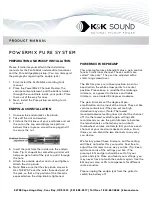
7
Plasmid DNA purification
MACHEREY-NAGEL – 08/ 2013, Rev. 01
Table 1: Kit specifications at a glance
Parameter
NucleoSpin
®
Plasmid EasyPure
Culture volume
2–10 mL
Typical yield
15–30 μg
Elution volume
50 μL
Binding capacity
35 μg
Vectors
< 15 kbp
Preparation time*
14 min /6 preps
Format
Mini spin column
2.3 Growth of bacterial cultures
Yield and quality of plasmid DNA highly depend on the type of culture media and
antibiotics, the bacterial host strain, the plasmid type, size, or copy number.
For cultivation of bacterial cells harbouring standard high-copy plasmids, we
recommend LB (Luria Bertani) medium. The cell culture should be incubated at
37 °C with constant shaking (200–250 rpm) preferably 12–16 h over night. Usually an
OD of 3–
6 can be achieved. Alternatively, rich media like 2 x YT (Yeast / Tryptone), TB
(Terrific Broth), or CircleGrow can be used. In this case bacteria grow faster, reach the
stationary phase much earlier than in LB medium (≤
12 h), and higher cell masses can
be reached. However, this does not necessarily yield more plasmid DNA. Overgrowing
a culture might lead to a higher percentage of dead or starving cells and the resulting
plasmid DNA might be partially degraded or contaminated with chromosomal DNA. To
find the optimal culture conditions, the culture medium and incubation times have to be
optimized for each host strain / plasmid construct combination individually.
Cell cultures should be grown under antibiotic selection at all times to ensure plasmid
propagation. Without this selective pressure, cells tend to lose a plasmid during cell
division. Since bacteria grow much faster without the burden of a high-copy plasmid,
they take over the culture rapidly and the plasmid yield goes down regardless of the
cell mass. Table 2 gives information on concentrations of commonly used antibiotics.
* Hands-on-time







































